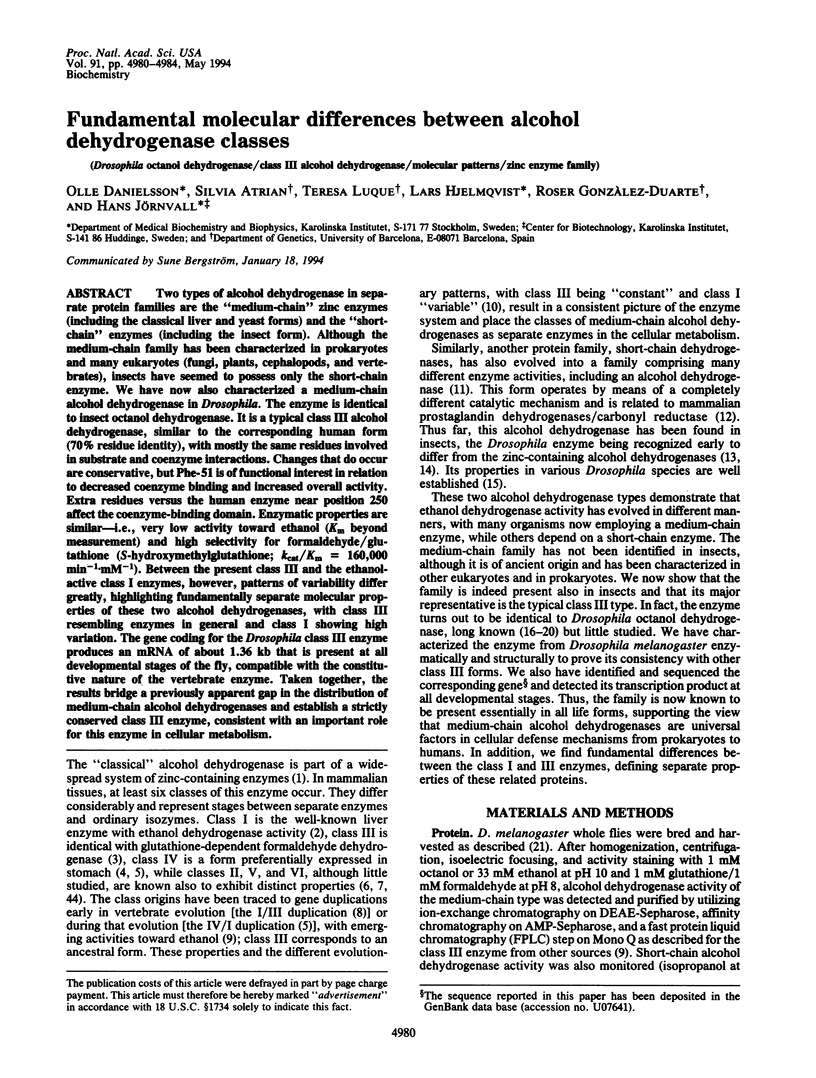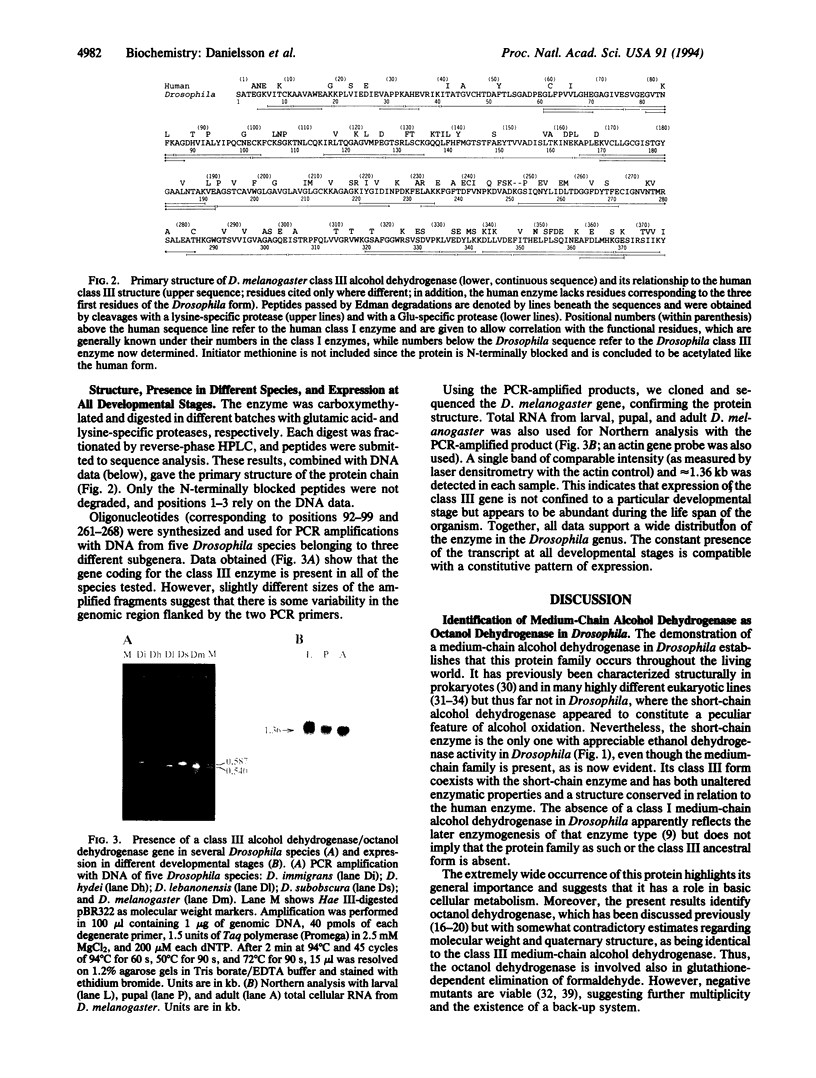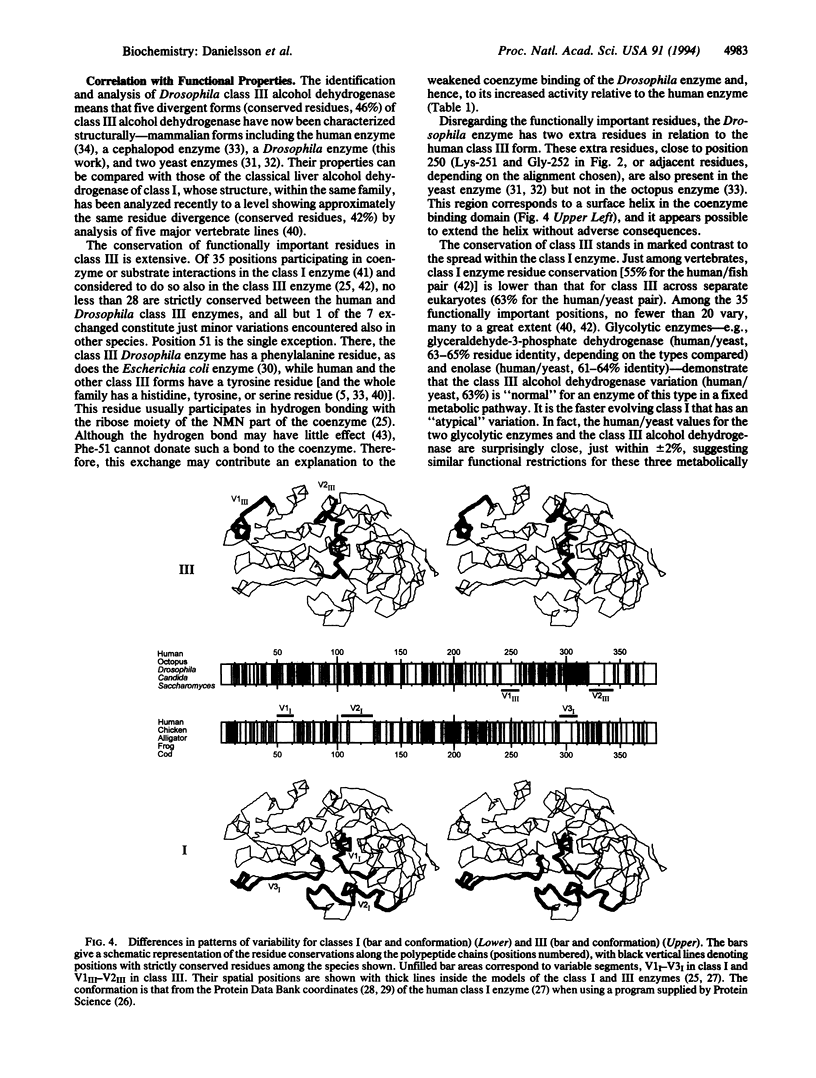Abstract
Two types of alcohol dehydrogenase in separate protein families are the "medium-chain" zinc enzymes (including the classical liver and yeast forms) and the "short-chain" enzymes (including the insect form). Although the medium-chain family has been characterized in prokaryotes and many eukaryotes (fungi, plants, cephalopods, and vertebrates), insects have seemed to possess only the short-chain enzyme. We have now also characterized a medium-chain alcohol dehydrogenase in Drosophila. The enzyme is identical to insect octanol dehydrogenase. It is a typical class III alcohol dehydrogenase, similar to the corresponding human form (70% residue identity), with mostly the same residues involved in substrate and coenzyme interactions. Changes that do occur are conservative, but Phe-51 is of functional interest in relation to decreased coenzyme binding and increased overall activity. Extra residues versus the human enzyme near position 250 affect the coenzyme-binding domain. Enzymatic properties are similar--i.e., very low activity toward ethanol (Km beyond measurement) and high selectivity for formaldehyde/glutathione (S-hydroxymethylglutathione; kcat/Km = 160,000 min-1.mM-1). Between the present class III and the ethanol-active class I enzymes, however, patterns of variability differ greatly, highlighting fundamentally separate molecular properties of these two alcohol dehydrogenases, with class III resembling enzymes in general and class I showing high variation. The gene coding for the Drosophila class III enzyme produces an mRNA of about 1.36 kb that is present at all developmental stages of the fly, compatible with the constitutive nature of the vertebrate enzyme. Taken together, the results bridge a previously apparent gap in the distribution of medium-chain alcohol dehydrogenases and establish a strictly conserved class III enzyme, consistent with an important role for this enzyme in cellular metabolism.
Full text
PDF




Images in this article
Selected References
These references are in PubMed. This may not be the complete list of references from this article.
- Bernstein F. C., Koetzle T. F., Williams G. J., Meyer E. F., Jr, Brice M. D., Rodgers J. R., Kennard O., Shimanouchi T., Tasumi M. The Protein Data Bank: a computer-based archival file for macromolecular structures. J Mol Biol. 1977 May 25;112(3):535–542. doi: 10.1016/s0022-2836(77)80200-3. [DOI] [PubMed] [Google Scholar]
- Cederlund E., Peralba J. M., Parés X., Jörnvall H. Amphibian alcohol dehydrogenase, the major frog liver enzyme. Relationships to other forms and assessment of an early gene duplication separating vertebrate class I and class III alcohol dehydrogenases. Biochemistry. 1991 Mar 19;30(11):2811–2816. doi: 10.1021/bi00225a011. [DOI] [PubMed] [Google Scholar]
- Chomczynski P., Sacchi N. Single-step method of RNA isolation by acid guanidinium thiocyanate-phenol-chloroform extraction. Anal Biochem. 1987 Apr;162(1):156–159. doi: 10.1006/abio.1987.9999. [DOI] [PubMed] [Google Scholar]
- Danielsson O., Eklund H., Jörnvall H. The major piscine liver alcohol dehydrogenase has class-mixed properties in relation to mammalian alcohol dehydrogenases of classes I and III. Biochemistry. 1992 Apr 21;31(15):3751–3759. doi: 10.1021/bi00130a004. [DOI] [PubMed] [Google Scholar]
- Danielsson O., Jörnvall H. "Enzymogenesis": classical liver alcohol dehydrogenase origin from the glutathione-dependent formaldehyde dehydrogenase line. Proc Natl Acad Sci U S A. 1992 Oct 1;89(19):9247–9251. doi: 10.1073/pnas.89.19.9247. [DOI] [PMC free article] [PubMed] [Google Scholar]
- Eklund H., Müller-Wille P., Horjales E., Futer O., Holmquist B., Vallee B. L., Hög J. O., Kaiser R., Jörnvall H. Comparison of three classes of human liver alcohol dehydrogenase. Emphasis on different substrate binding pockets. Eur J Biochem. 1990 Oct 24;193(2):303–310. doi: 10.1111/j.1432-1033.1990.tb19337.x. [DOI] [PubMed] [Google Scholar]
- Eklund H., Samama J. P., Jones T. A. Crystallographic investigations of nicotinamide adenine dinucleotide binding to horse liver alcohol dehydrogenase. Biochemistry. 1984 Dec 4;23(25):5982–5996. doi: 10.1021/bi00320a014. [DOI] [PubMed] [Google Scholar]
- Gutheil W. G., Holmquist B., Vallee B. L. Purification, characterization, and partial sequence of the glutathione-dependent formaldehyde dehydrogenase from Escherichia coli: a class III alcohol dehydrogenase. Biochemistry. 1992 Jan 21;31(2):475–481. doi: 10.1021/bi00117a025. [DOI] [PubMed] [Google Scholar]
- Hurley T. D., Bosron W. F., Hamilton J. A., Amzel L. M. Structure of human beta 1 beta 1 alcohol dehydrogenase: catalytic effects of non-active-site substitutions. Proc Natl Acad Sci U S A. 1991 Sep 15;88(18):8149–8153. doi: 10.1073/pnas.88.18.8149. [DOI] [PMC free article] [PubMed] [Google Scholar]
- Jacobson K. B., Murphy J. B., Knopp J. A., Ortiz J. R. Multiple forms of drosophila alcohol dehydrogenase. 3. Conversion of one form to another by nicotinamide adenine dinucleotide or acetone. Arch Biochem Biophys. 1972 Mar;149(1):22–35. doi: 10.1016/0003-9861(72)90295-0. [DOI] [PubMed] [Google Scholar]
- Juan E., González-Duarte R. Purification and enzyme stability of alcohol dehydrogenase from Drosophila simulans, Drosophila virilis and Drosophila melanogaster adhS. Biochem J. 1980 Jul 1;189(1):105–110. doi: 10.1042/bj1890105. [DOI] [PMC free article] [PubMed] [Google Scholar]
- Jörnvall H., Danielsson O., Eklund H., Hjelmqvist L., Hög J. O., Parés X., Shafqat J. Enzyme and isozyme developments within the medium-chain alcohol dehydrogenase family. Adv Exp Med Biol. 1993;328:533–544. doi: 10.1007/978-1-4615-2904-0_56. [DOI] [PubMed] [Google Scholar]
- Jörnvall H., Hög J. O., von Bahr-Lindström H., Vallee B. L. Mammalian alcohol dehydrogenases of separate classes: intermediates between different enzymes and intraclass isozymes. Proc Natl Acad Sci U S A. 1987 May;84(9):2580–2584. doi: 10.1073/pnas.84.9.2580. [DOI] [PMC free article] [PubMed] [Google Scholar]
- Kaiser R., Fernández M. R., Parés X., Jörnvall H. Origin of the human alcohol dehydrogenase system: implications from the structure and properties of the octopus protein. Proc Natl Acad Sci U S A. 1993 Dec 1;90(23):11222–11226. doi: 10.1073/pnas.90.23.11222. [DOI] [PMC free article] [PubMed] [Google Scholar]
- Kaiser R., Holmquist B., Vallee B. L., Jörnvall H. Characteristics of mammalian class III alcohol dehydrogenases, an enzyme less variable than the traditional liver enzyme of class I. Biochemistry. 1989 Oct 17;28(21):8432–8438. doi: 10.1021/bi00447a024. [DOI] [PubMed] [Google Scholar]
- Koivusalo M., Baumann M., Uotila L. Evidence for the identity of glutathione-dependent formaldehyde dehydrogenase and class III alcohol dehydrogenase. FEBS Lett. 1989 Oct 23;257(1):105–109. doi: 10.1016/0014-5793(89)81797-1. [DOI] [PubMed] [Google Scholar]
- Krook M., Ghosh D., Strömberg R., Carlquist M., Jörnvall H. Carboxyethyllysine in a protein: native carbonyl reductase/NADP(+)-dependent prostaglandin dehydrogenase. Proc Natl Acad Sci U S A. 1993 Jan 15;90(2):502–506. doi: 10.1073/pnas.90.2.502. [DOI] [PMC free article] [PubMed] [Google Scholar]
- Madhavan K., Conscience-Egli M., Sieber F., Ursprung H. Farnesol metabolism in Drosophila melanogaster: ontogeny and tissue distribution of octanol dehydrogenase and aldehyde oxidase. J Insect Physiol. 1973 Jan;19(1):235–241. doi: 10.1016/0022-1910(73)90236-9. [DOI] [PubMed] [Google Scholar]
- Moreno A., Parés X. Purification and characterization of a new alcohol dehydrogenase from human stomach. J Biol Chem. 1991 Jan 15;266(2):1128–1133. [PubMed] [Google Scholar]
- Moulis J. M., Holmquist B., Vallee B. L. Hydrophobic anion activation of human liver chi chi alcohol dehydrogenase. Biochemistry. 1991 Jun 11;30(23):5743–5749. doi: 10.1021/bi00237a016. [DOI] [PubMed] [Google Scholar]
- Ogonji G. O. Bearing of genetic data on the interpretation of the subunit structure of octanol dehydrogenase of Drosophila. J Exp Zool. 1971 Dec;178(4):513–522. doi: 10.1002/jez.1401780408. [DOI] [PubMed] [Google Scholar]
- Parés X., Cederlund E., Moreno A., Hjelmqvist L., Farrés J., Jörnvall H. Mammalian class IV alcohol dehydrogenase (stomach alcohol dehydrogenase): structure, origin, and correlation with enzymology. Proc Natl Acad Sci U S A. 1994 Mar 1;91(5):1893–1897. doi: 10.1073/pnas.91.5.1893. [DOI] [PMC free article] [PubMed] [Google Scholar]
- Persson B., Bergman T., Keung W. M., Waldenström U., Holmquist B., Vallee B. L., Jörnvall H. Basic features of class-I alcohol dehydrogenase: variable and constant segments coordinated by inter-class and intra-class variability. Conclusions from characterization of the alligator enzyme. Eur J Biochem. 1993 Aug 15;216(1):49–56. doi: 10.1111/j.1432-1033.1993.tb18115.x. [DOI] [PubMed] [Google Scholar]
- Persson B., Krook M., Jörnvall H. Characteristics of short-chain alcohol dehydrogenases and related enzymes. Eur J Biochem. 1991 Sep 1;200(2):537–543. doi: 10.1111/j.1432-1033.1991.tb16215.x. [DOI] [PubMed] [Google Scholar]
- Ribas De Pouplana L., Atrian S., Gonzàlex-Duarte R., Fothergill-Gilmore L. A., Kelly S. M., Price N. C. Structural properties of long- and short-chain alcohol dehydrogenases. Contribution of NAD+ to stability. Biochem J. 1991 Jun 1;276(Pt 2):433–438. doi: 10.1042/bj2760433. [DOI] [PMC free article] [PubMed] [Google Scholar]
- Richardson D. C., Richardson J. S. The kinemage: a tool for scientific communication. Protein Sci. 1992 Jan;1(1):3–9. doi: 10.1002/pro.5560010102. [DOI] [PMC free article] [PubMed] [Google Scholar]
- Sasnauskas K., Jomantiene R., Januska A., Lebediene E., Lebedys J., Janulaitis A. Cloning and analysis of a Candida maltosa gene which confers resistance to formaldehyde in Saccharomyces cerevisiae. Gene. 1992 Dec 1;122(1):207–211. doi: 10.1016/0378-1119(92)90052-q. [DOI] [PubMed] [Google Scholar]
- Schmid F., Hinz H. J., Jaenicke R. Studies on an energy structure-function relationship of dehydrogenases. I. Calorimetric investigations on the interaction of coenzyme fragments with horse liver alcohol dehydrogenase. FEBS Lett. 1978 Mar 1;87(1):80–82. doi: 10.1016/0014-5793(78)80138-0. [DOI] [PubMed] [Google Scholar]
- Schwartz M. F., Jörnvall H. Structural analyses of mutant and wild-type alcohol dehydrogenases from drosophila melanogaster. Eur J Biochem. 1976 Sep;68(1):159–168. doi: 10.1111/j.1432-1033.1976.tb10774.x. [DOI] [PubMed] [Google Scholar]
- Sieber F., Fox D. J., Ursprung H. Properties of octanol dehydrogenase from Drosophila. FEBS Lett. 1972 Oct 1;26(1):274–276. doi: 10.1016/0014-5793(72)80591-x. [DOI] [PubMed] [Google Scholar]
- Thatcher D. R., Sawyer L. Secondary-structure prediction from the sequence of Drosophila melanogaster (fruitfly) alcohol dehydrogenase. Biochem J. 1980 Jun 1;187(3):884–886. doi: 10.1042/bj1870884. [DOI] [PMC free article] [PubMed] [Google Scholar]
- Uotila L., Koivusalo M. Formaldehyde dehydrogenase from human liver. Purification, properties, and evidence for the formation of glutathione thiol esters by the enzyme. J Biol Chem. 1974 Dec 10;249(23):7653–7663. [PubMed] [Google Scholar]
- Ursprung H., Leone J. Alcohol dehydrogenases: a polymorphism in Drosophila melanogaster. J Exp Zool. 1965 Nov;160(2):147–154. doi: 10.1002/jez.1401600202. [DOI] [PubMed] [Google Scholar]
- Vallee B. L., Bazzone T. J. Isozymes of human liver alcohol dehydrogenase. Isozymes Curr Top Biol Med Res. 1983;8:219–244. [PubMed] [Google Scholar]
- Voelker R. A., Langley C. H., Brown A. J., Ohnishi S., Dickson B., Montgomery E., Smith S. C. Enzyme null alleles in natural populations of Drosophila melanogaster: Frequencies in a North Carolina population. Proc Natl Acad Sci U S A. 1980 Feb;77(2):1091–1095. doi: 10.1073/pnas.77.2.1091. [DOI] [PMC free article] [PubMed] [Google Scholar]
- Wagner F. W., Parés X., Holmquist B., Vallee B. L. Physical and enzymatic properties of a class III isozyme of human liver alcohol dehydrogenase: chi-ADH. Biochemistry. 1984 May 8;23(10):2193–2199. doi: 10.1021/bi00305a014. [DOI] [PubMed] [Google Scholar]
- Wehner E. P., Rao E., Brendel M. Molecular structure and genetic regulation of SFA, a gene responsible for resistance to formaldehyde in Saccharomyces cerevisiae, and characterization of its protein product. Mol Gen Genet. 1993 Mar;237(3):351–358. doi: 10.1007/BF00279438. [DOI] [PubMed] [Google Scholar]
- Yasunami M., Chen C. S., Yoshida A. A human alcohol dehydrogenase gene (ADH6) encoding an additional class of isozyme. Proc Natl Acad Sci U S A. 1991 Sep 1;88(17):7610–7614. doi: 10.1073/pnas.88.17.7610. [DOI] [PMC free article] [PubMed] [Google Scholar]
- Zheng Y. W., Bey M., Liu H., Felder M. R. Molecular basis of the alcohol dehydrogenase-negative deer mouse. Evidence for deletion of the gene for class I enzyme and identification of a possible new enzyme class. J Biol Chem. 1993 Nov 25;268(33):24933–24939. [PubMed] [Google Scholar]




